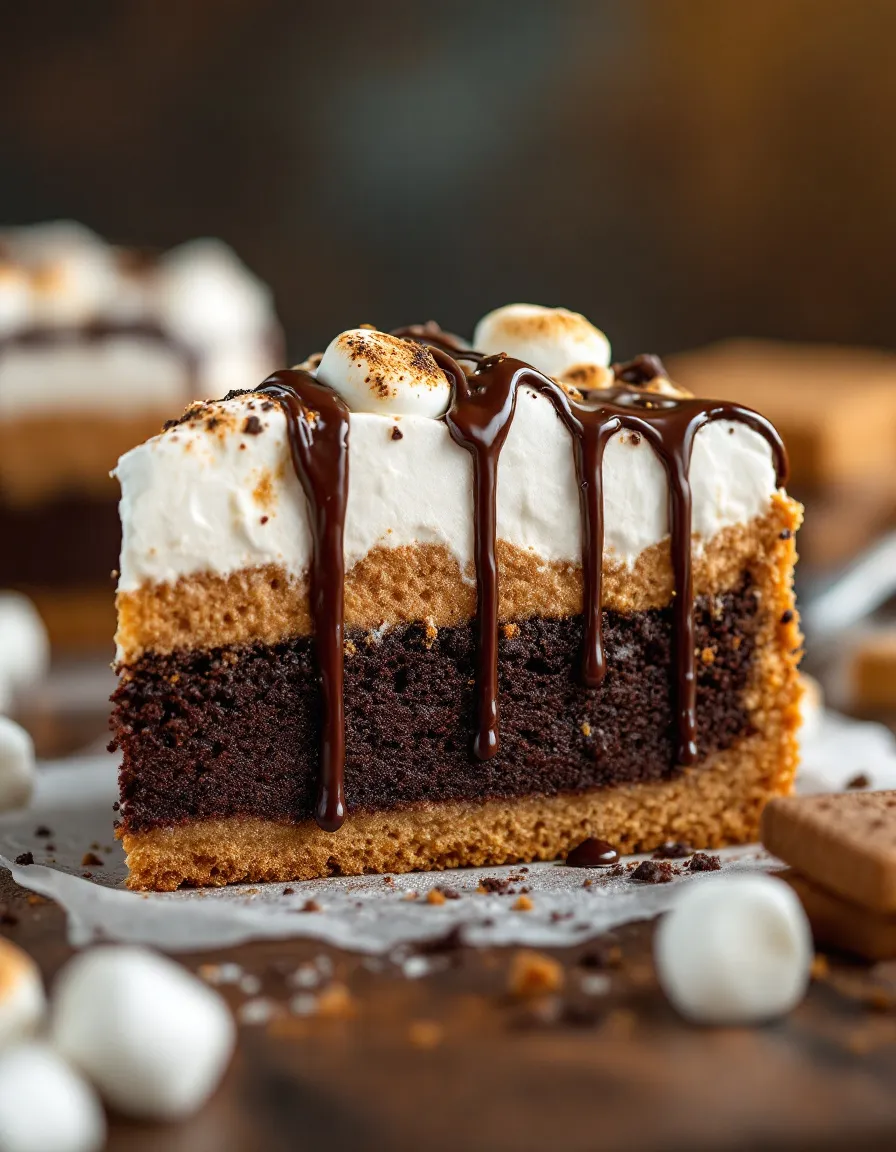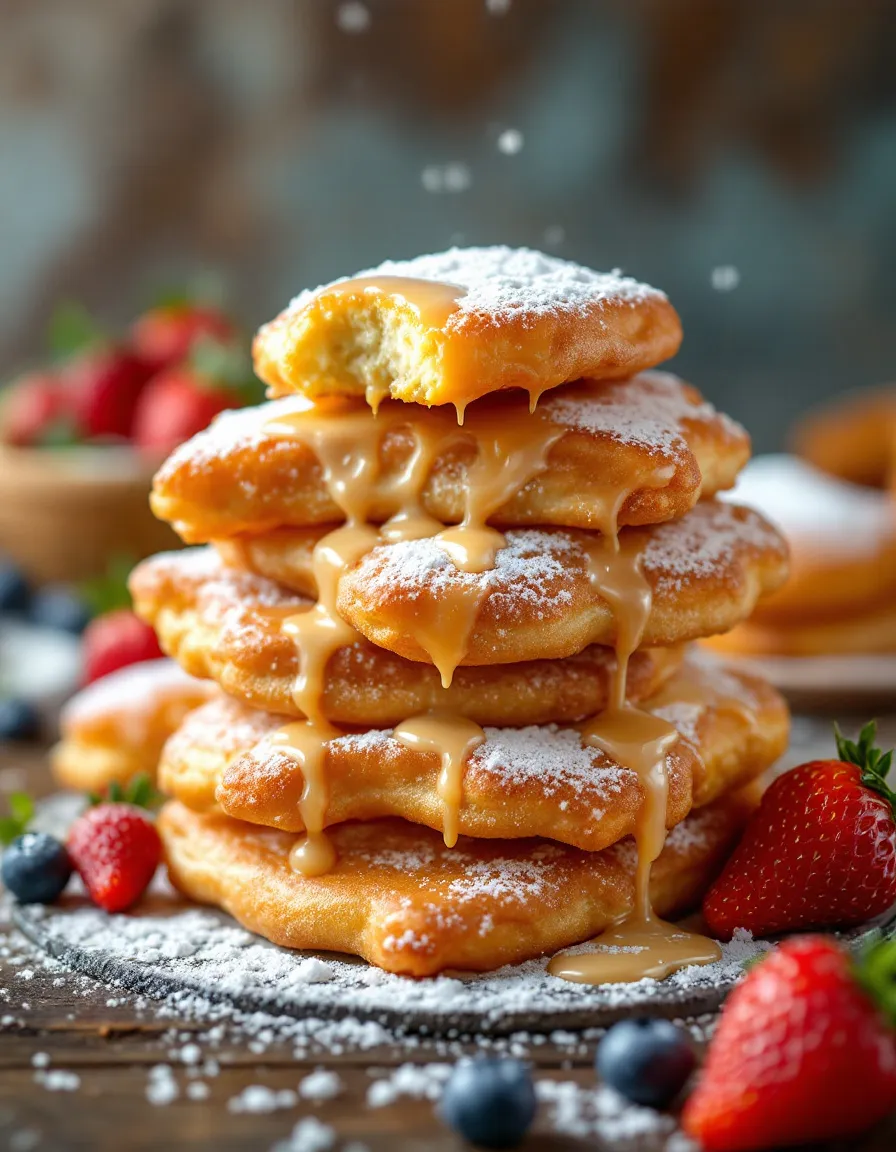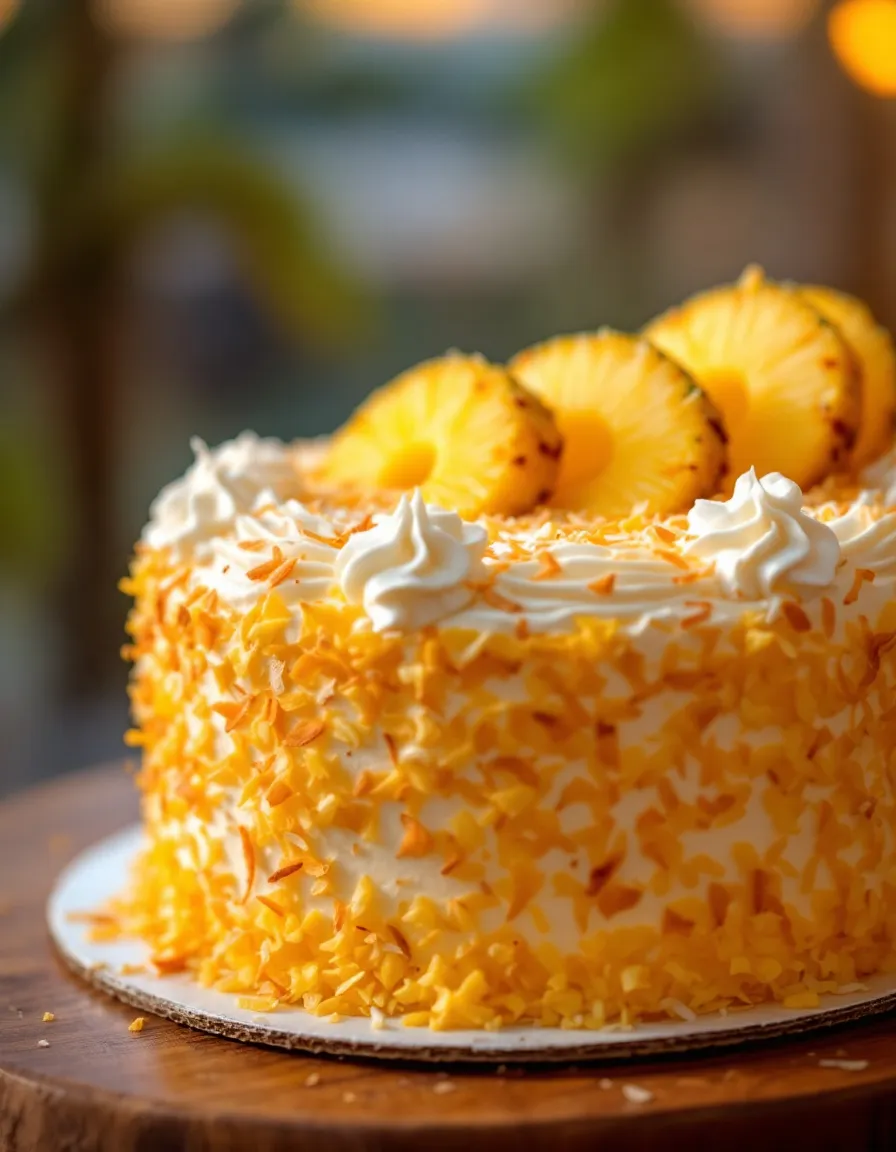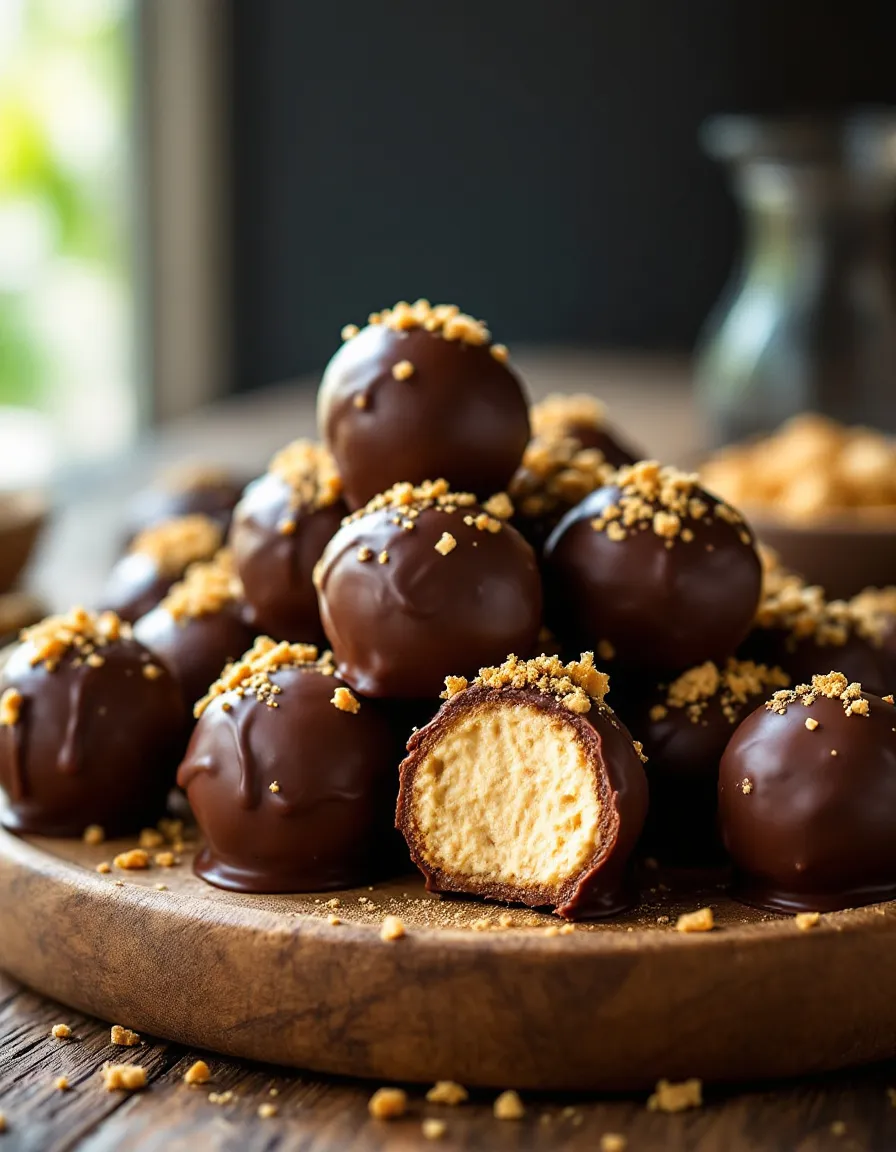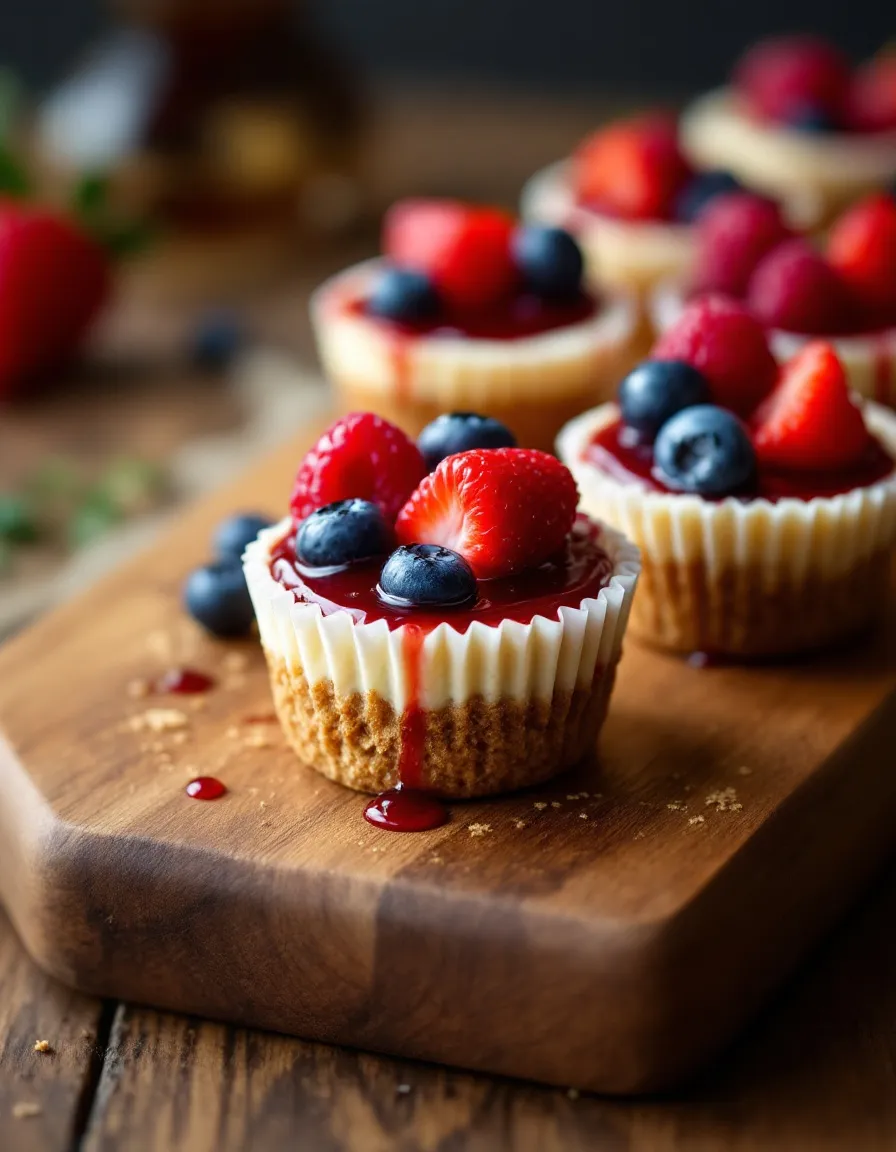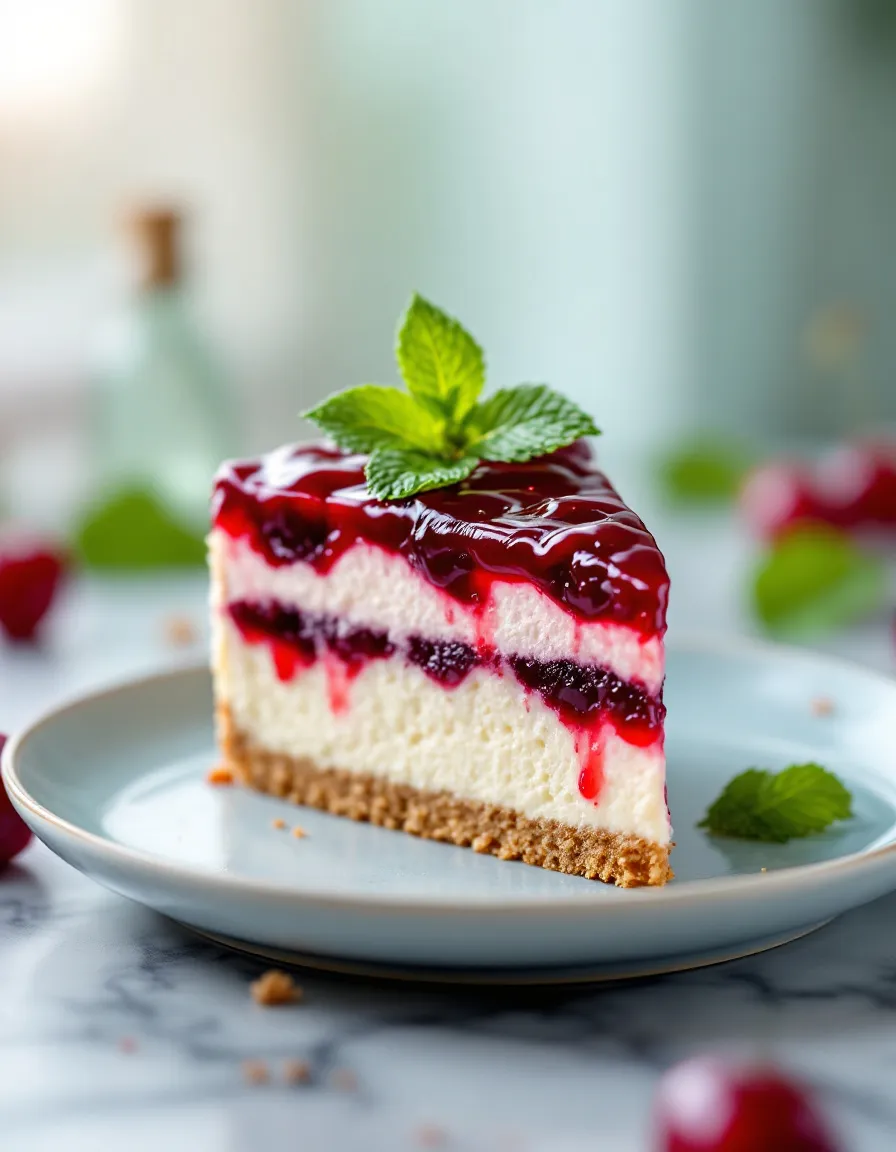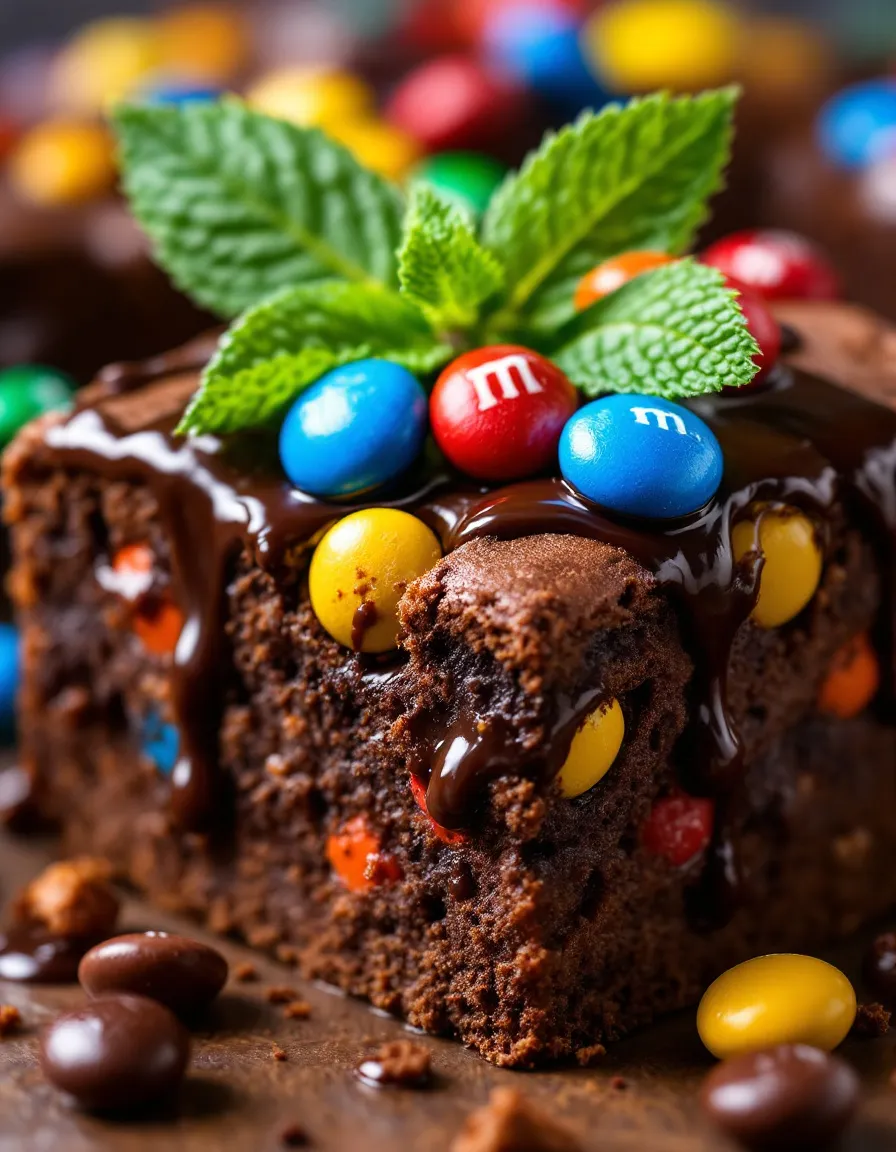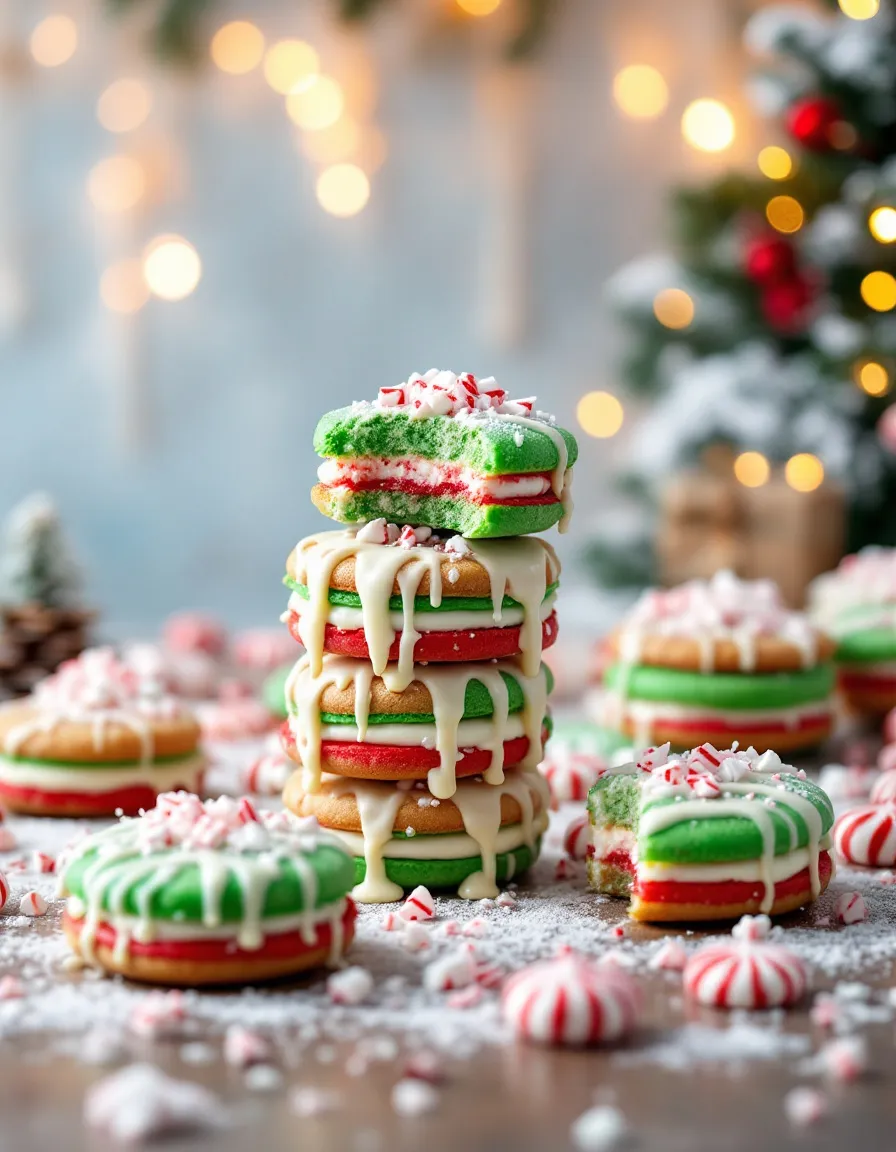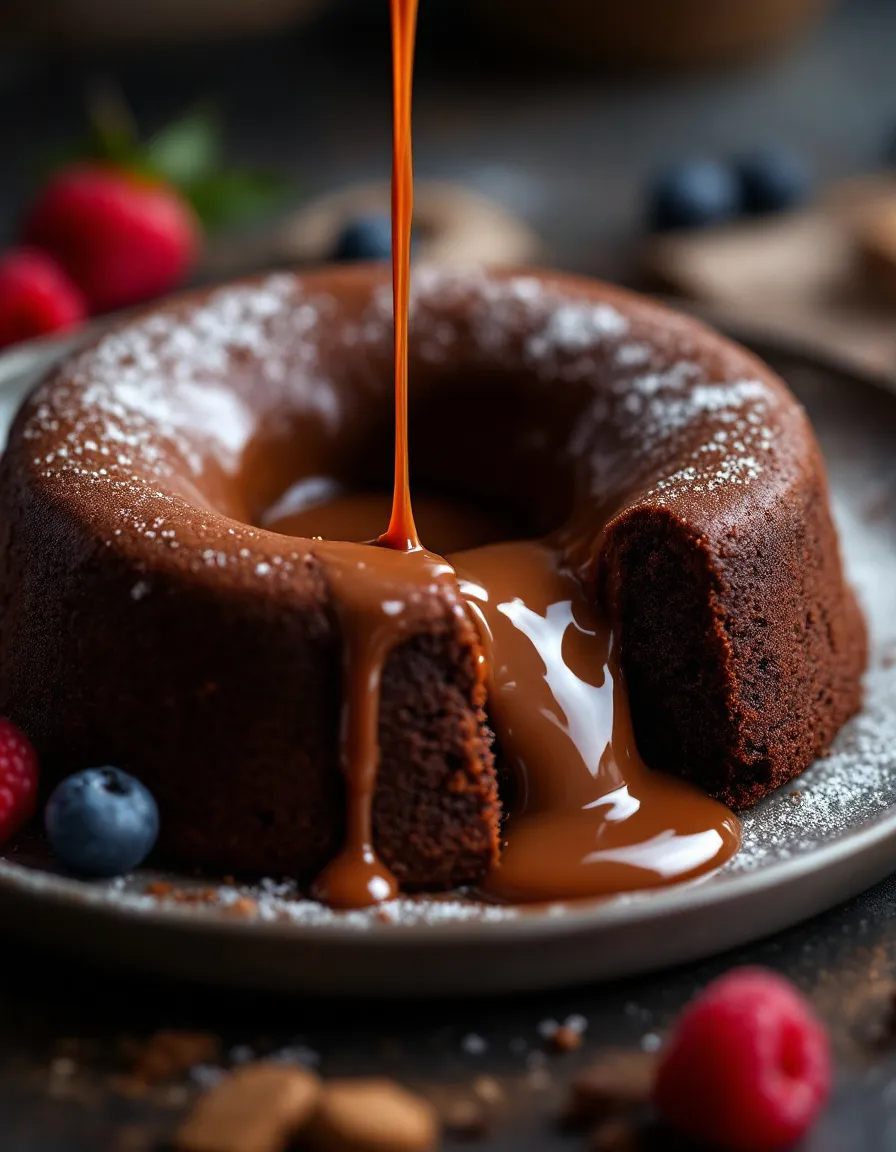S’mores Cake: A Delicious Twist on a Campfire Classic
S’mores Cake is a delightful dessert that brings the classic campfire treat into a moist, layered cake perfect for any occasion. The familiar flavors of graham crackers, chocolate, and toasted marshmallows meld together to create a harmonious blend that evokes nostalgia and comfort. Imagine slicing into a velvety cake that reminds you of cozy nights spent around a fire, making this dessert not just a recipe, but an experience.
The cake’s rich chocolate layers are complemented by creamy marshmallow frosting and a crust resembling the traditional graham cracker base. Each bite is an explosion of flavors and textures, tantalizing your taste buds with every forkful. This cake is not only visually appealing with its layers but also a crowd-pleaser that will leave everyone craving a second slice.
Quick Recipe Highlights
- Flavor Profile: This cake combines sweet, rich chocolate with a hint of nuttiness from graham crackers and a light, airy marshmallow taste.
- Texture: The soft, spongy cake contrasts beautifully with the smooth frosting and crunchy graham cracker crumble, creating a delightful mouthfeel.
- Aroma: The intoxicating aroma of melting chocolate and toasty marshmallows fills the air as it bakes, making it hard to resist this sweet treat.
- Visual Appeal: Layers of chocolate cake topped with fluffy white frosting and drizzled with chocolate ganache make this cake as beautiful as it is tasty.
- Skill Level Needed: This is a medium-difficulty recipe that requires basic baking skills and some assembly technique.
- Special Equipment: Prepare to use a mixer, cake pans, and a cooling rack to ensure perfect results.
Recipe Overview
- Difficulty Level: The S’mores Cake is rated as medium difficulty, suitable for experienced bakers who are familiar with layer cakes.
- Category: This dessert falls under the category of cakes, but it can also be considered a special occasion treat.
- Cuisine: S’mores Cake draws inspiration from American desserts, often associated with camping and outdoor gatherings.
- Cost: The approximate cost to make this cake is relatively low, primarily due to pantry staples like flour and sugar, with a few extra expenses for chocolate and marshmallows.
- Season: Perfect year-round, this cake is particularly popular in summer during barbecue season, as it brings outdoor flavors indoors.
- Occasion: This cake is ideal for birthday parties, family gatherings, or any celebration that calls for a sweet treat.
Why You’ll Love This Recipe
The S’mores Cake offers a unique sweet experience that combines familiar flavors in a new format. With each bite, the combination of rich chocolate and fluffy frosting transports you to a summer evening. The nostalgic essence of this cake sparks joyful memories of campfire gatherings, making it a beloved dessert for both kids and adults.
Preparation is a breeze, as the recipe is straightforward and doesn’t demand an extensive amount of time or effort. You’ll appreciate how quickly you can create an impressive dessert that looks as good as it tastes. Baking the layers ahead of time allows flexibility in your schedule, making it a convenient option for busy days.
Not only is this cake a feast for the palate, but it can also be adapted with healthier ingredients, making it a guilt-free indulgence. By substituting certain elements, you can create a version of this dessert that aligns with your dietary preferences without losing its signature flavors.
This S’mores Cake is the perfect centerpiece for any gathering, guaranteed to impress your guests. Sharing slices of this dessert can initiate conversations about favorite campfire memories, further adding to its entertaining value. Its engaging presentation and rich taste make it a conversation starter while you enjoy it with family and friends.
Lastly, the cost-effectiveness of this recipe makes it accessible for those on a budget. With simple ingredients that are often already in your pantry, you can whip up this delicious treat without breaking the bank. Enjoying homemade delight, especially one as popular as S’mores Cake, is truly rewarding.
Historical Background and Cultural Significance
The S’mores dessert has its roots in American outdoor culture, first documented in the 1920s. The delightful treat initially gained popularity among campers who made it over a fire, with recipes circulating in various cookbooks. This nostalgic treat showcases the joy of sharing simple pleasures around a campfire, evolving into the S’mores Cake variant today.
Culturally, S’mores symbolize outdoor adventures and family bonding experiences. Whether roasting marshmallows or baking during family gatherings, this dessert has become deeply embedded in American traditions. It reflects a time when families gathered outdoors, creating joyful memories that last a lifetime.
As time progressed, the S’mores recipe evolved significantly, leading to numerous adaptations. The cake version emerged as a modern twist, encapsulating the essence of the original treat while presenting a more elegant option for celebrations. This adaptation appeals to both the younger generation and adults who cherish fond memories of roasting marshmallows.
In regions across America, variations of S’mores exist, from adding peanut butter cups to incorporating local flavors. This adaptability showcases the universal appeal of the dessert, allowing different cultures to put their unique spin on it while still maintaining the essence of a cherished treat.
Ingredient Deep Dive
Graham Crackers
Graham crackers, a staple in many households, have a rich history dating back to the 19th century when they were developed as a health food. Initially created by Sylvester Graham, these biscuits were touted for their health benefits, making their way into many recipes, including the classic S’mores. In terms of nutrition, they provide a source of whole grains and dietary fiber. When selecting graham crackers for your S’mores Cake, look for varieties made with whole wheat for a nuttier flavor.
When it comes to storage, graham crackers should be kept in a cool, dry place to maintain their crispness. If you need to substitute them, crushed digestive biscuits or vanilla wafers can work well. Each alternative will slightly adjust the flavors, yet they can still create a delicious base for your cake.
Chocolate
Chocolate is at the heart of many desserts, and its rich history dates back thousands of years to ancient Mesoamerican cultures where it was revered. The nutritional values of chocolate vary based on its type; dark chocolate, for example, is rich in antioxidants and may provide heart health benefits. When choosing chocolate for this cake, opt for high-quality chunks or bars for the best melting and flavor improvement.
For those who have chocolate allergies or prefer alternatives, carob can be a reasonable substitution representing a similar flavor profile, albeit with a distinctly different taste. Proper storage of chocolate involves keeping it in a cool environment to maintain its texture and prevent blooming.
Marshmallows
Marshmallows have their roots in ancient cultures where the sap of the marshmallow plant was used to soothe coughs and sore throats. Today, they’re a popular sweet treat that adds a nostalgic element to S’mores. Though marshmallows are primarily sugar, they can be enjoyed in moderation. Look for artisanal marshmallows with natural ingredients for the best flavor.
Storing marshmallows requires airtight containers to ensure they maintain their puffy texture. If you’re looking for substitutes, consider vegan marshmallows made from alternative ingredients like agave or gelatin-free options. This maintains the marshmallow flavor without the animal product.
Butter
Butter is a key ingredient that adds moisture and richness to baked goods. Having a history that dates back to ancient times, it’s an essential component in many classic recipes. Nutritionally, butter contains fat-soluble vitamins while also being a source of saturated fat; however, it can enhance flavors significantly when used in baking.
To select quality butter, look for unsalted varieties for better control over your sweet recipe. When storing, keep butter in a cool place or the refrigerator to prolong its shelf life. If necessary, vegetable oils can be used as substitutes, though they may alter the cake’s final texture slightly.
Common Mistakes to Avoid
- Overmixing the batter: This can lead to a dense cake rather than a light and fluffy texture. Try mixing just until the ingredients are combined.
- Underbaking: Ensure the cake is baked through by checking with a toothpick. A little bit of moist crumb is fine, but too wet could mean raw batter.
- Not leveling the cake layers: Unleveled cakes can cause uneven stacking and a crooked cake. Use a serrated knife to ensure that each layer is flat.
- Skipping the cooling step: Removing the cake from the pans too soon can lead to breakage. Always let the cakes cool for a bit before transferring them.
- Using low-quality ingredients: The best flavors come from high-quality chocolate, butter, and other ingredients. Don’t skimp on quality for the best taste.
- Incorrect oven temperature: Always preheat your oven and use an oven thermometer if necessary to ensure it’s at the right temperature.
- Rushing the frosting: Allow the cake to cool completely before frosting to prevent the frosting from melting. Patience is key for a beautiful finish.
- Not letting the cake settle: Allowing the cake layers to rest helps flavors meld together. Serve them after allowing some time to settle.
- Ignoring storage guidelines: Improper storage can result in dry or stale cake. Keep it in airtight containers to maintain freshness.
- Forgetting toppings: Don’t forget the finishing touch. Adding toasted marshmallows or chocolate drizzle enhances the dessert’s appeal.
Essential Techniques
The process of making a layered cake involves several essential techniques that ensure each layer turns out just right. One is the creaming method, where you beat the butter and sugar together until light and fluffy. This method incorporates air into your batter, giving your cake a rise. To master this, beat on medium speed for about 2-3 minutes until it looks pale and fluffy, being careful not to overmix.
Another technique is cake layering, which requires the patience to cool each layer thoroughly before stacking. This not only prevents melting frosting but also ensures that the layers adhere effectively. Using a cake leveler or serrated knife helps create even layers for a professionally stacked cake, ensuring each slice is perfect and neat.
Pro Tips for Perfect S’mores Cake
Choose high-quality chocolate and butter to deepen flavor profiles in the cake and frosting. Incorporate a bit of espresso powder or instant coffee into the chocolate batter to enhance the chocolate’s richness. For visual appeal, toast marshmallows just before serving, creating a dynamic look and flavor contrast. Layer the cake with different chocolate textures using ganache in between layers while saving some of the graham cracker crust for the outer layer. Allow the cake to chill in the fridge before serving; this helps the flavors marry. Lastly, serve with whipped cream and a sprinkle of graham cracker crumbs for added texture and presentation.
Variations and Adaptations
For regional variations, consider incorporating local flavors like pecans for southern flair or coconut flakes for a tropical twist. Seasonally, adapt your S’mores Cake to a pumpkin spice version by adding pumpkin puree and spices. Dietary modifications allow for gluten-free options using almond flour or a gluten-free cake mix, ensuring everyone can enjoy it. Flavor variations like adding mint extract or orange zest can elevate the aromas, while texture modifications such as adding chocolate chips or nut pieces add more crunch. In presentation, consider serving mini cakes in jars or cupcake form for fun, individual-sized portions for gatherings.
Serving and Presentation Guide
To present your S’mores Cake beautifully, use a rotating cake stand to achieve even frosting and perfect decorating. Garnish with toasted marshmallows on top, providing a delightful contrast in textures and a nostalgic appeal. Drizzling remaining chocolate ganache over the top before serving will enhance the visual and taste experience. Consider serving individual slices with a side of graham cracker crumbs for extra crunch and decor. When it comes to temperature, ensure the cake is moderately chilled for the best serving experience, which helps prevent the frosting from becoming too soft.
Wine and Beverage Pairing
Pairing the S’mores Cake with dessert wines like a rich port or sweet dessert wine beautifully complements its chocolatey flavors. Alternatively, a bold, fruity red wine enhances the cake without overpowering its sweetness. For non-alcoholic beverages, consider serving with a rich hot chocolate that echoes the dessert’s flavors or a refreshing iced coffee. When serving with coffee or tea, opt for a rich espresso or a creamy chai that brings warmth and spice. These carefully selected pairings will elevate the dessert experience.
Storage and Shelf Life
Proper storage of S’mores Cake is essential for maintaining freshness. Keep it in an airtight container at room temperature for up to three days, or refrigerate for up to a week. Avoid leaving cake unwrapped, as it can dry out quickly. If you notice any signs of spoilage like a dried-out crust or unusual smells, it’s best to discard it. When reheating, do so gently in the microwave to keep the texture intact. For longer storage, consider freezing portions wrapped tightly in plastic and aluminum foil; it will maintain its best quality for up to three months.
Make Ahead Strategies
To make your S’mores Cake ahead of time, bake the layers one or two days before the event. Wrap the cooled layers in plastic wrap and store them in the refrigerator. The night before serving, frost the cake while the layers are still cold for easier handling. Ensure you keep the frosting separate until you are ready to assemble to maintain its texture. This approach allows the flavors to deepen while preserving the cake’s moisture. You can also prepare a compote or supplementary chocolate sauce up to a week before for added flavor on the day of serving.
Scaling Instructions
Scaling the S’mores Cake recipe involves simple adjustments to ingredients and equipment. For halving, use an 8-inch cake pan; the baking time may need reducing slightly. Doubling or tripling the recipe can be easily done using larger pans, like 12-inch rounds, adjusting cooking times depending on the oven. When doubling, make sure to mix in batches if your mixer can’t handle larger amounts. Always check for doneness using the toothpick method, as thicker layers may require longer bake times. Ensure proper storage allowances for larger batches to prevent spoilage.
Nutritional Deep Dive
Breaking down the nutrition in S’mores Cake involves analyzing macronutrients, where the cake contains a balance of carbs from the sugar and flour, fats from butter and chocolate, and minimal protein. It’s vital to consider micronutrients like calcium and iron derived from chocolate and graham crackers. While indulgent, enjoying this cake in moderation can fit into various diets by managing portion sizes. Consider using lighter substitutions for ingredients to lower calorie counts or boost health benefits while keeping enjoyment high. Understanding these factors can help balance indulgence with healthier choices.
Dietary Adaptations
For dietary adaptations, consider gluten-free variations using almond or oat flour to create a delightful gluten-free S’mores Cake version without compromising flavor. Those avoiding dairy can opt for coconut cream for frosting or vegan butter for a fully dairy-free cake. A vegan recipe can also replace eggs with substitutions like applesauce or flaxseed meal. For low-carb or keto diets, alternatives can include almond flour for a lighter base and sugar substitutes like erythritol for sweetness. Each of these dietary modifications ensures that everyone can enjoy this delightful dessert regardless of their dietary restrictions.
Troubleshooting Guide
If you encounter texture issues such as a tough cake, it may have been overmixed; ensure mixing stops once just combined. A dry cake often results from overbaking; always monitor baking times closely. If flavor balance is off, consider enhancing sweetness with powdered sugar or balancing bitterness with a touch of salt. Temperature problems may arise if using multiple oven racks or not preheating properly; always give enough time for complete preheating. For ingredient substitutions affecting taste, always taste-test while adjusting to find the best replacements, ensuring a delicious outcome.
Recipe Success Stories
Community feedback highlights how S’mores Cake has become a favorite for potlucks and family gatherings, with many sharing their personal adaptations. Readers have tried variations like incorporating caramel sauce with positive testimonials about its rich flavor. Others suggest using fondant for decorative purposes while maintaining the plushness of the cake. Photography tips from readers include highlighting the cake’s layers by slicing through the middle or showcasing the toasty marshmallows as a topping. These stories build a connection around shared experiences with this beloved recipe.
Frequently Asked Questions
Can I make S’mores Cake ahead of time?
Yes, you can prepare the cake layers in advance and frost them the day of serving for optimal freshness.
What can I use instead of graham crackers?
Alternatives include crushed digestive biscuits or vanilla wafers for a similar texture and flavor.
How should I store leftovers?
Store any leftover S’mores Cake in an airtight container at room temperature for up to three days or refrigerate for up to a week.
Can I freeze S’mores Cake?
Yes, you can freeze the cake. Wrap it tightly in plastic wrap and aluminum foil to maintain freshness, lasting up to three months.
Is there a vegan version of this cake?
Yes, you can replace eggs with flaxseed meal and use vegan butter and dairy-free chocolate for a vegan S’mores Cake.
How can I adjust sweetness?
Adjust the sweetness by adding more powdered sugar to the frosting or using a sugar substitute for the cake.
What temperature should I bake at?
Bake the S’mores Cake at 350°F (175°C) for best results.
How can I get the perfect frosting consistency?
Ensure your butter is at room temperature before mixing to achieve the right texture. Adding a bit of milk can also help if it’s too thick.
Can I make a gluten-free version?
Yes, substituting regular flour for gluten-free flour blends works well in this recipe.
What drinks pair well with S’mores Cake?
Rich dessert wines, hot chocolate, or iced coffee enhance the flavor of this delightful cake.
Additional Resources
For those looking to explore more delicious recipes, check out our collection of decadent chocolate desserts, or dive into technique guides that help with baking fundamentals. You might also be interested in ingredient-specific articles that discuss the best types of chocolate to use or how to choose the right marshmallows. Recommendations for necessary cooking equipment can assist in successfully making this cake and many others. Don’t hesitate to explore seasonal variations to keep your dessert game fresh and exciting year-round.
Join the Conversation
We love to hear from you! Feel free to share your bakery adventures, adaptations of this S’mores Cake, or creative serving ideas on our social media platforms. You can also submit your photography tips and recipe reviews for a chance to be featured. Engage with fellow baking enthusiasts for community support and inspiration, and share your variations to create a wider array of delicious delights!
The Recipe
S’mores Cake
Serves: 12
Prep Time: 30 mins
Cook Time: 25 mins
Total Time: 55 mins
Kitchen Equipment Needed
- Mixing bowl
- Electric mixer
- Cake pans (9-inch)
- Cooling rack
- Spatula
- Rubber scraper
Ingredients
- 1 ¾ cups all-purpose flour
- 1 ¾ cups granulated sugar
- ¾ cup unsweetened cocoa powder
- 1 ½ teaspoons baking powder
- 1 ½ teaspoons baking soda
- 1 teaspoon salt
- 2 large eggs
- 1 cup milk
- ½ cup vegetable oil
- 2 teaspoons vanilla extract
- 1 cup boiling water
- 2 cups mini marshmallows
- 1 cup chocolate chips
- 1 cup crushed graham crackers
- 1 cup unsalted butter, softened
- 4 cups powdered sugar
- 1 teaspoon vanilla extract (frosting)
Directions
- Preheat the oven to 350°F (175°C). Grease and flour two 9-inch cake pans.
- In a large mixing bowl, combine flour, sugar, cocoa powder, baking powder, baking soda, and salt.
- Add eggs, milk, oil, and vanilla extract to the dry ingredients and mix until smooth.
- Stir in boiling water gradually to thin the batter.
- Divide the batter evenly between the prepared cake pans.
- Bake for 25-30 minutes, or until a toothpick inserted comes out clean. Allow to cool.
- For the frosting, beat the softened butter until creamy. Gradually add in powdered sugar and vanilla, mixing until well combined and fluffy.
- Once the cakes are cool, place one layer on a serving plate. Spread a layer of frosting on top and sprinkle with mini marshmallows and chocolate chips.
- Top with the second cake layer. Frost the top and sides of the cake, using the remaining frosting to cover.
- Garnish by sprinkling crushed graham crackers and additional mini marshmallows on top.
Recipe Notes
- Store leftover cake in an airtight container to retain moisture.
- This cake can be made vegan by substituting flax eggs for eggs and using vegan butter.
- For an ultra chocolatey experience, use chocolate frosting instead of vanilla.
- You can toast the marshmallows on top slightly under a broiler just before serving for a beautiful finish.
